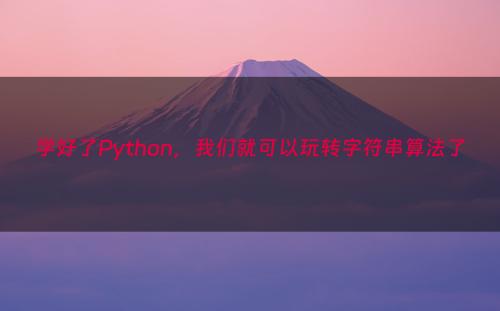网站首页 > 基础教程 正文
Python 在处理字符串方面非常强大,提供了多种内置方法和库来支持复杂的字符串操作和算法。下面,我将介绍几种常见的字符串算法以及它们在 Python 中的实现实例。

1. 字符串反转
字符串反转是一个基础且常见的操作,Python 提供了非常简洁的切片操作来实现这一功能。
```python
def reverse_string(s):
return s[::-1]
示例
original_string = "hello"
reversed_string = reverse_string(original_string)
print(reversed_string) # 输出: olleh
```
2. 字符串搜索
字符串搜索是查找子串在字符串中首次出现的位置。Python 的 `str.find()` 方法可以完成这一任务。
```python
def search_substring(s, sub):
return s.find(sub)
示例
main_string = "hello world"
substring = "world"
index = search_substring(main_string, substring)
if index != -1:
print(f"'{substring}' found at index {index}")
else:
print(f"'{substring}' not found")
```
3. 字符串替换
字符串替换是将字符串中指定的子串替换为另一个子串的过程。Python 的 `str.replace()` 方法可以实现这一点。
```python
def replace_substring(s, old_sub, new_sub):
return s.replace(old_sub, new_sub)
示例
original_string = "hello world"
replaced_string = replace_substring(original_string, "world", "Python")
print(replaced_string) # 输出: hello Python
```
4. 字符串拼接
字符串拼接是将多个字符串连接成一个字符串的过程。Python 支持使用加号 `+` 或者 `join()` 方法进行字符串拼接。
```python
使用加号
def concatenate_strings(s1, s2):
return s1 + s2
使用 join()
def concatenate_strings_list(strings_list):
return ''.join(strings_list)
示例
s1 = "hello"
s2 = "world"
print(concatenate_strings(s1, s2)) # 输出: helloworld
strings_list = ["hello", " ", "world"]
print(concatenate_strings_list(strings_list)) # 输出: hello world
```
5. 字符串分割
字符串分割是将字符串按照指定的分隔符分割成多个子串的过程。Python 的 `str.split()` 方法可以实现这一功能。
```python
def split_string(s, delimiter):
return s.split(delimiter)
示例
sentence = "hello,world,python"
words = split_string(sentence, ",")
print(words) # 输出: ['hello', 'world', 'python']
```
这些只是一些基本的字符串算法和它们的 Python 实现。在实际开发中,你可能会遇到更复杂的字符串处理任务,这时候可能需要结合正则表达式(`re` 模块)或其他高级字符串处理库来解决问题。
猜你喜欢
- 2024-10-31 Python办公神器:教你如何快速分拆、删页、合并PDF文件
- 2024-10-31 Python3中的字符串操作 python3 字符串操作
- 2024-10-31 玩转Python—字符串使用教程 python字符串常用方法
- 2024-10-31 你会在 Python 中使用字符串吗? python字符串怎么用
- 2024-10-31 Python3中可能不会用到的10个功能!但是能让你的代码更简洁直观
- 2024-10-31 python作业(三) python编程作业
- 2024-10-31 手把手教你写爬虫 |Python 采集大众点评数据采集实战
- 2024-10-31 「python杂谈」使用多个分隔符分隔字符串
- 2024-10-31 如何用Python+OpenCV处理图像色彩?终于有人讲明白了
- 2024-10-31 字符串基本操作2-2-Python3零基础入门
- 最近发表
- 标签列表
-
- jsp (69)
- gitpush (78)
- gitreset (66)
- python字典 (67)
- dockercp (63)
- gitclone命令 (63)
- dockersave (62)
- linux命令大全 (65)
- pythonif (86)
- location.href (69)
- dockerexec (65)
- tail-f (79)
- queryselectorall (63)
- location.search (79)
- bootstrap教程 (74)
- 单例 (62)
- linuxgzip (68)
- 字符串连接 (73)
- html标签 (69)
- c++初始化列表 (64)
- mysqlinnodbmyisam区别 (63)
- arraylistadd (66)
- mysqldatesub函数 (63)
- window10java环境变量设置 (66)
- c++虚函数和纯虚函数的区别 (66)
